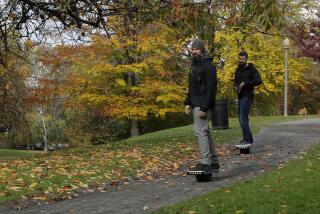Wheeling Into the ER
- Share via
Ten-year-old Justin Griffin swings his feet onto his metal scooterboard and pushes himself down a slight hill in Irvine’s University Park, where a small group of fellow fifth-graders are daredevil dueling on the hottest toy of summer.
Picking up speed, he grips the rubber-covered handlebar and leaps over a curb--at one with his sparkling, green-wheeled scooter--and spins it in a midair circle beneath his feet before landing hard, and braking harder, just inches short of his admiring audience. The last time he tried this “360-spinner” trick, which was just minutes ago, Justin fell on his knee, which is still bleeding but doesn’t seem to hurt anymore.
“That was so phat!” he shouts. (Translation: That was so awesome.) “Did you see that? I rock so hard.”
With their speed (up to 35 miles an hour downhill), their portability (a compact 6 pounds), and their snazzy design (including a rainbow of wheel colors to choose from), the newest metal kick-powered scooters have soared above any other fad or toy this year. Scooter industry officials expect to sell at least 2 million more “razor”-style boards before Christmas.
But the scooters have been sending thousands of riders--mostly children under 15--to emergency rooms with a host of injuries, prompting the federal Consumer Product Safety Commission this week to issue a warning about a gadget so popular that few stores can keep them on their shelves. Some Orange County school districts have discussed banning the scooters from elementary campuses, or at least asking parents to prevent students from riding them to school.
“They’re irresistible to kids,” said Marcia Kerr, an Orange County consumer information officer with the safety commission. “But parents need to be reminded that they can be dangerous. We’ve seen a huge number of injuries in just a short amount of time.”
Through Aug. 27, 9,411 emergency room scooter injuries have been reported to the safety commission, ranging from cuts and sprains to broken bones, dislocations and head wounds. And while no deaths have been reported in the survey of 101 emergency rooms across the nation, many Orange County emergency room physicians and orthopedic specialists say it’s only a matter of time.
“I never, ever see kids wearing protective gear on scooters, and they are just as dangerous as Rollerblades,” said Dr. Ray Ricci, vice chairman of emergency services at Hoag Memorial Hospital Presbyterian in Newport Beach. Contributing to the surge in scooter-related injuries, doctors said, is a false sense of security that many riders feel because the board sits low to the ground, has a handlebar to hold for balance and an easy-to-reach push-down rear brake. And because the handlebar is adjustable to each rider’s height, children as young as 3 are able to get around on the scooters.
Those same elements of security also have prompted a large number of adults to try the latest mode of transportation. As a result, doctors said, they are seeing a much broader range in the ages of injured patients than with any other wheeled sport.
At Children’s Hospital of Orange County at Mission Viejo, for example, emergency room officials have treated an average of four or five scooter riders every weekend day this summer; skateboarders account for half that and bicyclists even less. Dr. Mike Ritter, the ER’s assistant medical director, said the scooter injuries have included a 3 1/2-year-old boy with a broken arm and a 71-year-old grandmother with a broken wrist.
“It all comes down to that handle,” Ritter said of the scooterboards. “Adults think, ‘Aw, I can do that!’ and kids think, ‘I can do that faster and higher and harder.’ And what people don’t realize is how quickly these things can start moving and how difficult they can be to steer.”
Consistent with treatment given at other ERs in the county, Ritter said the majority of the injuries treated at Children’s Hospital could have been avoided had the riders been wearing a helmet, elbow and knee pads.
For 7-year-old Lauren Wong of Irvine, however, even wearing full protective gear couldn’t save her fingers from being fractured during a recent fall at University Park. It was the second spill she took this summer; the first resulted in a knee contusion that prompted her mother, Gina, to enforce the protective pad rule.
“She doesn’t like it because none of her friends are wearing [pads], but I just don’t care,” said Wong, who purchased scooters in June for both Lauren and her 6-year-old brother. “They can’t have enough protection on these things as far as I’m concerned. They’re just not as safe as most parents think.”
Still, doctors and safety commission officials acknowledged that getting children to wear protective gear on scooters may prove difficult, and many young riders--convinced of their invincibility and cruising the streets on the last day of summer vacation--agreed.
“I don’t need that stuff,” said 10-year-old Taylor Grant, who glided around his Mission Viejo cul-de-sac Wednesday with a tangle of scootering friends, all pad- and helmet-free. “I fall sometimes, but I’m fine. I never get hurt.”
Taylor Green, also 10, said she rides her orange-wheeled scooter for fun, not so much to try out tricks.
“Girls are safer I think,” she said. “We don’t jump off the voltage boxes and stuff.”
(BEGIN TEXT OF INFOBOX / INFOGRAPHIC)
Rolling Hazard
Those lightweight aluminum scooters that kids are zipping around on are shaping up as a big hazard, according to a recent study. Scooter-related injuries topped 9,411 so far this year, more than the previous two years combined.
Non-powered Scooter Injuries, By year (injuries treated in hospital emergency rooms)
1998 3,782
1999 3,281
2000 9,411*
June 2000: 1,304
Aug. 2000: 4,140
* Body Part Injured (including cuts, sprains, fractures and dislocations)
Head/face: 29%
Arm/hand: 44%
Leg/foot: 22%
*as of Aug. 27
Source: U.S. Consumer Product Safety Commission






